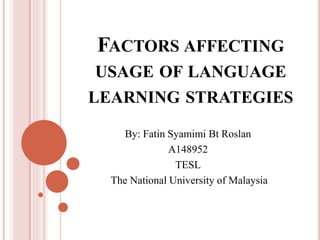
Factors affecting usage of language learning strategies
- 1. FACTORS AFFECTING USAGE OF LANGUAGE LEARNING STRATEGIES By: Fatin Syamimi Bt Roslan A148952 TESL The National University of Malaysia
- 2. MOTIVATION Gardner (1985) Motivation and attitudes are the primary sources contributing to individual language learning . Described the phenomenon of motivation as consisting of four components: a goal, effort, want, and attitudes toward the learning activity. Dörnyei (2001) Motivation can be a matter explaining why people decide to do something, how long they are willing to sustain the activity, and how hard they are going to pursue it.
- 3. Oxford and Nyikos (1989) Indicate that the learners with high motivation to learn a language will likely use a variety of strategies. In terms of language learning, achievement can be viewed as one of indexes of motivation since motivation can lead to and support all activities. Pintrich and Schunk (2002) Pointed out that motivation involves all activities in the classroom. Motivation affects learning of new behaviors and the performance of earlier learned behaviors.
- 4. GENDER Hong-Nam and Leavell (2006) Investigated learning strategy use of 55 students learning English with different cultural and linguistic background. Mean differences revealed that females engaged in strategy use more frequently than males. Female participants reported using Social and Metacognitive strategies most and Memory strategies the least. Males favored the use of Metacognitive and Compensation strategies most and Affective strategies the least.
- 5. Tran (1988) and Wharton (2000) In sharp contrast, studies by Tran and Wharton designate that males used learning strategies more than females when learning a language . In terms of gender difference, the finding showed that males used a greater number of strategies significantly more often than females. Males were more likely to use a variety of learning strategies than females.
- 6. EXPERIENCES IN STUDYING A LANGUAGE Purdie and Oliver (1999) Reported the English language learning strategies used by bilingual school-aged children coming from three main cultural groups: Asian, European and Arabic. Students who had been in Australia for a longer period of time (3 or less years and 4 or more) obtained significantly higher mean scores for Cognitive strategies and for Memory strategies.
- 7. Opper, Teichler, and Carlson (1990) Carried out a comprehensive study investigating studying abroad programs in Europe and The United States. Studying abroad is deemed to have an influence on students’ thought and learning style, especially in their actual ability in language learning.
- 8. LANGUAGE LEARNING STYLES AND PREFERENCES Neil Fleming’s VARK model One of the most common and widely used categorizations of the various types of language learning styles. He categorizes learners into: visual learner, auditory learner, read and write learner and kinesthetic learner. Ehrman and Oxford (1989) An individual’s learning style preferences influence the type of learning strategies that they use. Rossi-Le (1995) Learners who favor group study are shown to use social and interactive strategies, such as working with peers or requesting clarification
- 9. PERSONALITY Personality traits that affect usage of language learning strategies are: Extroversion : interest in and involvement with people and things outside the self Introversion : the state of or tendency toward being wholly or predominantly concerned with and interested in one's own mental life Inhibition: a feeling that makes one self-conscious and unable to act in a relaxed and natural way. Risk-taking: an ability of being eager to try out new information intelligently regardless of embarrassment Self-esteem: a term used to reflect a person's overall emotional evaluation of his or her own worth Anxiety: a feeling of worry, nervousness, or unease typically about an imminent event or something with an uncertain outcome Empathy: the ability to put oneself in another’s shoes
- 10. Extroversion vs. Introversion Ehrman and Oxford (1989) Conducted a survey exploring the relationships between personality types and strategy use on the SILL. Extroverts were found to use two categories of strategies (affective and visualization) more frequently than introverts. Introverts made a greater use of strategies for searching and communicating meaning than did the extroverts. Extroverts have demonstrated strong preference for social strategies, while introverts use metacognitive strategies more frequently.
- 11. Inhibition Ehrman (1993) Inhibition is closely related to self-esteem: the weaker the self-esteem, the stronger the inhibition to protect the weak ego. Suggests that students with thick, perfectionist boundaries find language learning more difficult than those learners with thin boundaries who favour attitudes of openness and the tolerance of ambiguity.
- 12. Risk taking Because of a strong intention of achieving success on learning something they yearn for mastering, language learners are willing to absorb new knowledge from their teacher spontaneously. Brown (2001) “Interaction requires the risk of failing to produce intended meaning, of failing to interpret intended meaning, of being laughed at, of being shunned or rejected. The rewards, of course, are great and worth the risks”.
- 13. Self-esteem In the context of language learning, low self-esteem can have serious consequences. Students may avoid taking the necessary risks to acquire communicative competence in the target language. They may feel deeply insecure and even drop out of the class. In the language classroom it is important to be concerned about learners’ self-esteem.
- 14. Anxiety Any task that involves a certain degree of challenge can expose the learner to feelings of self-doubt, uneasiness or fear. Anxiety can be considered a negative factor in language learning. MacIntyre and Gardner (1991) Conducted on state anxiety indicate that foreign language anxiety can have a negative effect on the language learning process.
- 15. Empathy Empathy is predicted to be relevant to acquisition in that the empathic person may be the one who is able to identify more easily with speakers of a target language and thus accept their input as intake for language acquisition.